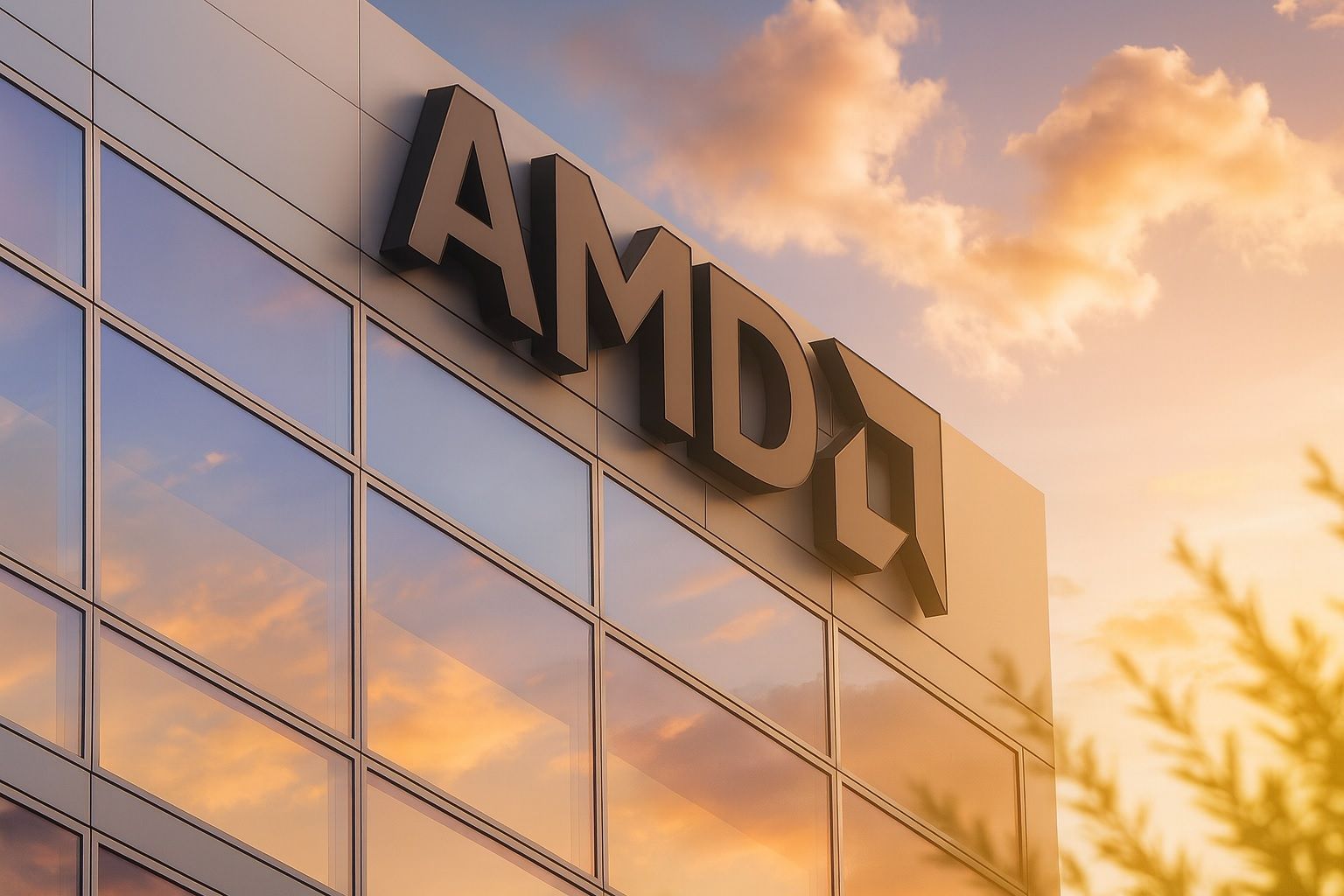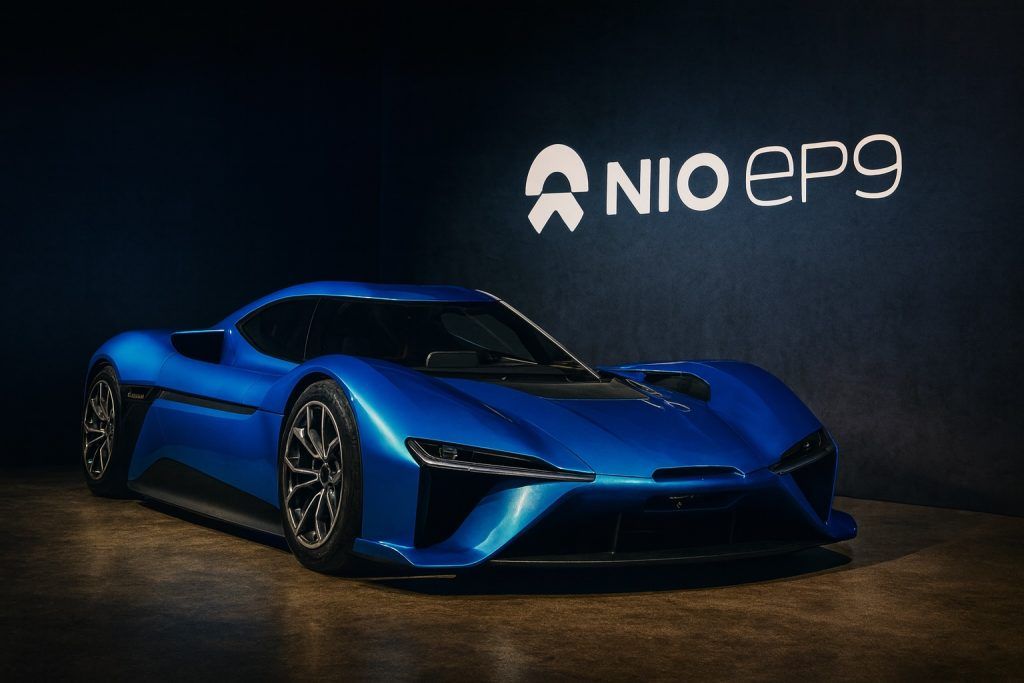- Blistering 2025 Rally: AMD shares have surged nearly 80% year-to-date, vastly outperforming peers. The stock hit an all-time high around $238 last week (Oct. 15) after explosive AI-fueled gains, then eased to about $233 by Friday’s close [1]. In the past month alone, AMD jumped ~46%, lifting its 2025 gain to roughly 92%. A broad tech rally on AI optimism (Philly semiconductor index +32% YTD) has boosted AMD’s market cap to ~$350 billion [2].
- AI Mega-Deals Fuel Surge: Two blockbuster partnerships ignited AMD’s latest leap. On Oct. 6, AMD announced a multi-year AI chip supply deal with OpenAI – a 6-gigawatt order of GPUs – and gave OpenAI warrants to buy up to ~10% of AMD’s shares at a nominal price [3]. Then on Oct. 14, Oracle Cloud said it will deploy 50,000 of AMD’s next-gen MI450 GPUs in new AI superclusters [4]. AMD expects “more than $100 billion in new revenue” over four years from these deals [5]. The stock soared over 30% in one day on the OpenAI news and jumped another ~3% after the Oracle announcement [6].
- Wall Street Gets Bullish: Analysts are racing to upgrade AMD. Bank of America, Jefferies, and Wolfe Research all lifted their 12-month price targets to $300 after the OpenAI deal, and HSBC went even higher to $310 [7]. Many cite improved visibility into AMD’s AI roadmap (e.g. the new MI450 “Helios” platform) as justification [8]. Roughly 60–65% of analysts now rate AMD a “Buy,” and the average target has jumped to the mid-$200s – though a few skeptics like Goldman Sachs cling to Neutral ratings with targets around $210 [9].
- Battle for the AI Crown: AMD’s moves underscore its ambition in AI chips, but the company still trails a dominant rival. NVIDIA commands an estimated 90%+ of the AI GPU market [10], powering most large-scale AI models. Intel, long on the sidelines, is re-entering the race too – it unveiled a new data-center AI chip (“Crescent Island”) coming in 2026 [11], and NVIDIA even invested $5 billion for a 4% stake in Intel to co-develop future chips [12]. AMD’s strategy is to offer an “open” alternative to NVIDIA’s proprietary systems, leveraging its Instinct AI GPUs, EPYC server CPUs, and the just-unveiled “Helios” rack-scale platform to win over cloud giants [13]. Oracle, Meta, and OpenAI have already signaled plans to adopt AMD’s Helios/MI450-based systems once they launch in 2026 [14].
- Lofty Valuation & Upcoming Earnings: AMD’s stock now reflects lofty expectations. Shares trade around 40× expected 2026 earnings (trailing P/E over 100), a rich multiple even above NVIDIA’s (~30×) [15]. Such high valuation leaves “little room for error” if growth falters [16]. All eyes are on AMD’s Q3 earnings report due Nov. 4 – the company guided for ~$8.7 billion in revenue (+20% YoY) [17]. Last quarter’s sales were a record $7.68 billion (+32% YoY), and AMD is targeting ~$33 billion for full-year 2025 [18]. Investors will be watching whether AMD can sustain its breakneck growth to justify its near-record share price.
- Big Long-Term Bets: Looking further out, AMD’s AI partnerships represent a massive bet on future growth. Bank of America sees AMD on a “path to $10+” in annual EPS by 2027 [19], implying significant stock upside if realized. Notably, the OpenAI deal includes warrants that only fully vest if AMD’s stock soars to ~$600 [20] – underlining the potential magnitude of this AI opportunity. Bulls argue AMD could keep climbing as it captures more AI market share, while skeptics warn that execution risks and fierce competition could temper those lofty ambitions.
Soaring Stock on AI Hype
Advanced Micro Devices has been one of 2025’s star performers on Wall Street. The stock has nearly doubled this year amid a broader tech rally driven by artificial intelligence optimism. As of mid-October, AMD was up roughly 80% year-to-date, far outpacing peers (for context, NVIDIA was up ~40% YTD, while Intel was only modestly higher) [21]. The gains went parabolic in October – AMD rocketed from about $165 in early October to over $230 per share, including a stunning +34% single-day spike on Oct. 6 after a major announcement [22]. The stock notched a record intraday and closing high near $238 on Oct. 15 before cooling slightly into week’s end. Even after a slight pullback, AMD closed last Friday around $233, keeping it “hovering near record levels” heading into Monday [23] (Oct. 20, 2025).
This surge comes amid a euphoric backdrop for tech. The Nasdaq and S&P 500 have recently notched all-time highs as investors pile into AI-related plays [24]. Chip stocks in particular are on fire – the Philadelphia Semiconductor Index is up ~32% in 2025 [25]. AMD’s market capitalization now hovers around $350 billion, ranking it the world’s third-largest chipmaker behind only much-larger rivals NVIDIA and Intel [26]. In short, “AI fever” has propelled AMD into the market’s upper echelon. The big question now is whether the company’s fundamentals can catch up with its red-hot stock price.
AI Mega-Deals Ignite AMD’s Rally
The catalyst for AMD’s latest leg up was a pair of blockbuster AI deals that signal booming demand for its chips. First came the OpenAI partnership unveiled October 6. AMD agreed to supply 6 gigawatts worth of AI processors (hundreds of thousands of GPUs) to OpenAI – one of the largest AI chip orders ever. In a novel twist, OpenAI also secured warrants to purchase up to 160 million AMD shares (roughly 10% of the company) at just $0.01 per share [27]. Essentially, OpenAI gets to share in AMD’s upside, aligning both firms’ interests. AMD’s CEO Lisa Su touted the agreement as a “win-win, enabling the world’s most ambitious AI buildout”, and CFO Jean Hu said it should “deliver tens of billions of dollars in revenue” and be “highly accretive” to AMD’s earnings over time [28] [29]. OpenAI CEO Sam Altman, for his part, welcomed having a second supplier (beyond Nvidia) to help scale OpenAI’s massive AI infrastructure. Wall Street’s reaction was unequivocal: AMD shares soared over 30% in one day on the news [30], adding roughly $80 billion to AMD’s market value overnight.
Just over a week later, AMD scored another big win – this time with Oracle. On Oct. 14, Oracle Cloud announced it will deploy 50,000 of AMD’s upcoming Instinct MI450 GPUs in new AI supercomputer clusters [31]. The rollout is slated to begin in late 2026 and expand in 2027, aligning with when AMD’s next-gen chips (and its new “Helios” systems) will be ready [32]. Oracle’s goal is to build cutting-edge AI cloud capacity, and it chose AMD as a key partner alongside its existing heavy use of Nvidia hardware. Oracle touted the AMD alliance as providing “the best price-performance, open, secure, and scalable cloud foundation” for AI workloads [33]. Even in a choppy broader market, the Oracle news gave AMD a noticeable boost – shares jumped about 3% in pre-market trading on Oct. 14 while the overall indexes struggled [34].
Why are these deals so significant? In short, they validate AMD as an emerging force in AI computing. For years, Nvidia has dominated the AI processor space virtually unchallenged, with an estimated 90%+ market share in data-center AI GPUs [35]. AMD’s presence has been minimal (low single digits). But OpenAI committing to AMD silicon – and Oracle following suit – signals that top-tier tech players see AMD’s AI technology as viable and worth investing in. As one analyst put it, the OpenAI pact is a major “vote of confidence” in AMD’s AI chips, even if Nvidia still holds a huge lead [36]. Leah Bennett of Westwood Group (speaking to Reuters) summed it up: the OpenAI deal “helps validate [AMD’s] technology” in AI, though AMD still “trails Nvidia for quite some time” in market leadership [37] [38].
Financially, the upside could be enormous if AMD executes. AMD itself projects over $100 billion of new revenue in the next four years from the OpenAI and Oracle agreements and related AI wins [39]. For perspective, AMD’s total revenue last year was under $25 billion, so this figure is staggering. Of course, most of that $100B would accrue in later years (primarily once chip deliveries ramp up in 2026–2027). In the near term, these announcements won’t suddenly boost this quarter’s sales – but they dramatically improve the long-term growth runway investors see for AMD. That future promise has been a major driver of the stock’s surge.
AMD’s “Open” Strategy vs. Nvidia and Intel
Underlying these deals is AMD’s strategy to differentiate itself from the industry Goliath, Nvidia. AMD is pitching a more “open” AI ecosystem in contrast to Nvidia’s vertically integrated approach. The clearest example came at the mid-October Open Compute Project (OCP) summit, where AMD unveiled its new “Helios” rack-scale AI platform – essentially an all-AMD supercomputer design for large-scale AI deployments [40] [41]. Helios combines AMD’s Instinct data-center GPUs, EPYC server CPUs, and Pensando networking chips, all tied together with open-standard interconnects and software (the ROCm open AI software stack). It’s built on an open rack design contributed by Meta to the OCP community, emphasizing interoperability and easy scaling [42].
In rolling out Helios, AMD took direct aim at Nvidia’s popular DGX systems. “Open collaboration is key to scaling AI efficiently,” said Forrest Norrod, head of AMD’s data-center unit, contrasting Helios’s mix-and-match flexibility against Nvidia’s fully proprietary systems [43]. AMD even claims a Helios rack can provide 50% more total memory for AI models than Nvidia’s upcoming equivalent, thanks to design choices like 432GB of HBM4 memory per GPU [44]. The open design also promises easier maintenance and the ability to use different vendors’ components – appealing features for cloud players who don’t want to be locked into a single supplier.
Crucially, big customers are interested. Oracle’s 50k-GPU order is effectively a commitment to AMD’s Helios architecture. Meta Platforms (Facebook’s parent) is reportedly evaluating Helios for its own data centers [45]. And of course OpenAI’s future mega-clusters will be built on AMD’s forthcoming MI300X/MI450 chips. These wins give AMD a foothold to challenge Nvidia’s dominance. As Bank of America analyst Vivek Arya noted, the OCP Summit victories give greater “visibility into the deployment and ramp” of AMD’s AI hardware in 2026–27 [46]. In fact, Arya now models that AMD will capture roughly half of the huge OpenAI order over that period – which could translate to nearly $10 billion in extra sales by 2027 and annual earnings around $10–11 per share if all goes well [47].
Still, Nvidia isn’t standing still. It remains the entrenched incumbent with ~90% of the AI chip market [48]. Nvidia’s current H100 GPUs (and next-gen “Vera Rubin” chips due soon) are omnipresent in AI data centers worldwide, and Nvidia’s software stack (CUDA and AI libraries) is the de facto standard for developers. Tellingly, Nvidia has shown it will partner when advantageous – it agreed to invest $5 billion for a 4% stake in Intel as part of a plan to co-develop future PC and data-center chips [49]. Intel, for its part, has a new CEO vowing to reinvigorate its AI efforts after past stumbles. At the OCP event, Intel revealed a forthcoming “Crescent Island” data-center AI GPU (aimed at AI inference tasks) due in 2026 [50]. Intel is also embracing a more open, modular approach – allowing mixing and matching chips – and promised to release new AI chips on a yearly cadence like its rivals [51]. In short, the battle for AI silicon leadership is intensifying from all sides. AMD may have momentum now, but it will need flawless execution to turn its current opportunity into lasting market share gains.
Wall Street’s Upbeat Forecasts
Following AMD’s game-changing deals and product showcase, Wall Street sentiment has flipped resoundingly bullish. In the past two weeks, a flurry of analyst upgrades and target hikes poured in, many predicting substantial further upside for AMD’s stock. The most optimistic forecasts now see AMD approaching the $300 per share milestone within the next 12 months – which would be another ~30% above Friday’s ~$233 level.
For instance, longtime AMD bull Mark Lipacis of Jefferies raised his target to $300 (from $200) right after the OpenAI deal, arguing the partnership significantly boosts AMD’s long-term earnings potential [52]. HSBC was even bolder, upping its target all the way from $200 to $310 following the news [53]. Wolfe Research likewise joined the “$300 club,” upgrading AMD to Outperform with a $300 target and stating the company is now on a “conservative path to $10+ earnings power” by 2027 [54]. (For context, AMD’s EPS last year was under $3, so $10+ would be a dramatic jump – reflecting the huge anticipated AI-driven growth.) Bank of America’s noted chip analyst Vivek Arya also bumped his target to $300 (from $250), saying the OpenAI and Helios revelations gave him increased confidence in AMD’s AI roadmap [55].
Overall, about 60–65% of analysts covering AMD now rate it a Buy [56]. The average 12-month price target has climbed into the mid-$200s, versus around $180–$200 a few months ago. That said, not everyone is fully on board the hype train. A few skeptics remain cautious – notably Goldman Sachs and Citigroup have stuck with Neutral ratings and relatively modest ~$210 price targets [57]. Goldman acknowledged the OpenAI deal as a “substantial positive” but cited potential funding risks and heavy customer concentration in AMD’s data-center GPU business as ongoing concerns [58] [59]. In other words, a lot now has to go right for AMD to justify the bulls’ optimism.
It’s also worth noting the scale of AMD’s long-term bet as implied by the OpenAI deal structure. The warrant package granted to OpenAI vests in tranches only as certain deployment and stock price milestones are met – culminating in the final tranche vesting only if AMD’s share price hits roughly $600 [60]. That doesn’t mean anyone explicitly predicts $600 in the near future, but it shows the upper bound of what OpenAI and AMD alike must be envisioning as possible if their AI partnership truly succeeds. Some analysts have even mused on such blue-sky scenarios; for example, one Seeking Alpha contributor outlined a “path to $600” longer-term if AMD’s AI initiatives exceed expectations. While those projections are speculative, they underscore how transformative the AI opportunity could be for AMD’s valuation if the company executes to perfection.
Valuation and Near-Term Outlook
All the optimism has catapulted AMD’s valuation into lofty territory. The stock now trades around 40 times its projected 2026 earnings – a premium even to high-flying Nvidia (about 30×) – and its trailing P/E is well into triple digits [61]. Such rich multiples indicate investors are pricing in significant growth ahead. The flip side is that there is little room for error. As TS2.Tech noted, AMD’s current valuation leaves “little room for error” if its growth story stumbles [62]. In practical terms, AMD will need to deliver high-octane revenue and profit gains over the coming years (as the AI deals ramp up) to support its stock price. Any sign of delays, execution hiccups, or weaker-than-expected demand could prompt a sharp correction when expectations are this elevated.
In the immediate term, the next big catalyst is AMD’s Q3 2025 earnings, due on November 4. The company has guided to about $8.7 billion in quarterly revenue, which would be roughly +20% year-over-year [63]. That suggests AMD’s core businesses (PC chips, gaming GPUs, and data-center CPUs/GPUs) are already seeing solid growth even before the new AI deals kick in. Last quarter’s results were strong – AMD posted a record $7.68 billion in sales (+32% YoY) [64] – and the firm is targeting ~$33 billion revenue for full-year 2025 [65]. Investors will be keen to hear any updates on data-center GPU demand, AI chip production timelines, and how the company plans to fulfill the huge OpenAI order starting in 2026. Given the stock’s recent run-up, expectations are high. A robust report with upbeat guidance could further bolster the bull case, whereas any hint of softness (or cautious commentary from CEO Lisa Su about the road ahead) might give the market pause.
Market context will also play a role. The broader stock market and tech sector sentiment – recently buoyant thanks to AI mania – could introduce volatility. Any shifts in interest rates, geopolitical tensions (especially U.S.–China tech frictions), or rotation out of tech could impact AMD shares in the short run, even if the company’s long-term thesis remains intact.
Bottom Line
AMD enters the week of Oct. 20, 2025 riding high on optimism that it can claim a much bigger role in the AI revolution. The stock’s incredible 2025 rally – capped by landmark deals with OpenAI and Oracle – reflects investors’ belief that AMD is poised to challenge the giants in semiconductors. There is real substance behind the hype: AMD is making bold moves to expand its chip offerings, big-name customers are signing on, and analysts see tremendous earnings potential if these bets pay off. In many ways, 2025 has been a breakthrough year for AMD’s strategic position in the industry.
However, the road ahead comes with a high bar. At its current near-record price, AMD’s stock is priced for perfection. To keep climbing, the company will need to execute flawlessly – hitting product launch timelines, scaling up chip production, and winning additional big customers – all while fending off aggressive competition from Nvidia (and a resurgent Intel). The next 12–18 months will test whether AMD can convert today’s pipeline of deals and prototypes into tomorrow’s revenue and profits. If the AI boom continues and AMD secures even a mid-single-digit slice of that market, the stock’s momentum could very well continue – perhaps even toward the ambitious $300+ targets bulls have set. But if growth disappoints or the AI frenzy cools, AMD’s lofty valuation could prove unforgiving.
For now, AMD has given investors plenty of reason for excitement going into year-end 2025. The company has placed a audacious bet on being a prime beneficiary of the AI age. The coming quarters will show whether that bet pays off – and whether AMD’s stock can live up to the sky-high expectations riding on it. As of today, the momentum is firmly in its favor [66], and the world will be watching to see if AMD can turn this momentum into lasting success.
Sources: TS2.tech (TechStock²) [67] [68]; Reuters [69] [70]; Investing.com [71] [72]; company statements and analyst reports.
References
1. ts2.tech, 2. ts2.tech, 3. ts2.tech, 4. ts2.tech, 5. ts2.tech, 6. ts2.tech, 7. ts2.tech, 8. ts2.tech, 9. ts2.tech, 10. ts2.tech, 11. ts2.tech, 12. ts2.tech, 13. ts2.tech, 14. ts2.tech, 15. ts2.tech, 16. ts2.tech, 17. ts2.tech, 18. ts2.tech, 19. ts2.tech, 20. www.investing.com, 21. ts2.tech, 22. ts2.tech, 23. ts2.tech, 24. ts2.tech, 25. ts2.tech, 26. ts2.tech, 27. ts2.tech, 28. ts2.tech, 29. ts2.tech, 30. ts2.tech, 31. ts2.tech, 32. ts2.tech, 33. ts2.tech, 34. ts2.tech, 35. ts2.tech, 36. ts2.tech, 37. ts2.tech, 38. ts2.tech, 39. ts2.tech, 40. ts2.tech, 41. ts2.tech, 42. ts2.tech, 43. ts2.tech, 44. ts2.tech, 45. ts2.tech, 46. ts2.tech, 47. ts2.tech, 48. ts2.tech, 49. ts2.tech, 50. ts2.tech, 51. ts2.tech, 52. ts2.tech, 53. ts2.tech, 54. ts2.tech, 55. ts2.tech, 56. ts2.tech, 57. ts2.tech, 58. www.investing.com, 59. www.investing.com, 60. www.investing.com, 61. ts2.tech, 62. ts2.tech, 63. ts2.tech, 64. ts2.tech, 65. ts2.tech, 66. ts2.tech, 67. ts2.tech, 68. ts2.tech, 69. www.reuters.com, 70. www.reuters.com, 71. www.investing.com, 72. www.investing.com







